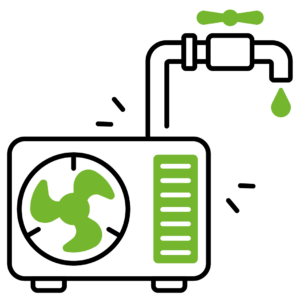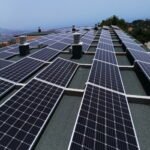
Hello and welcome to Solares Energies! We’re thrilled to be your go-to experts for solar storage solutions in the beautiful regions of Malaga and Cadiz. At Solares Energies, we’re passionate about harnessing the power of the sun to create a sustainable, energy-efficient future for everyone. – If you’re looking for the best Solar Battery Storage Costa del Sol has to offer, then look no further! We’re perfectly placed to support the Costa del Sol and Southern Spain with our offices in Marbella, Malaga and Pueblo Nuevo, San Roque.
Local Expertise: Based in Spain with offices in Marbella, Malaga and Pueblo Nuevo, near Sotogrande, Cadiz, we have a deep understanding of the local climate and how to maximise solar energy in these sunny regions.
Cutting-Edge Technology: We stay at the forefront of solar technology, offering you the latest and most efficient solar storage solutions.
Friendly, Professional Service: Our team is not just skilled and experienced, but also friendly and approachable. We’re here to make your transition to solar energy smooth and enjoyable.
Tailored Solutions: Whether you’re a homeowner looking to reduce energy bills or a business seeking a sustainable energy source, we tailor our solar storage solutions to meet your specific needs.
With Solares Energies, stepping into the world of solar energy is easy and rewarding. Our solar storage systems not only provide you with a reliable source of green energy but also offer significant savings in the long run. Say goodbye to rising energy costs and hello to a cleaner, more sustainable way of living.
We invite you to explore our range of solar storage options and find out how we can help you harness the sun’s power more effectively. Our team is excited to work with you, ensuring that your experience with solar energy is nothing short of fantastic.
Unlock Continuous Green Energy: Solar battery storage, also known as solar panel batteries, revolutionises how you utilise solar energy. By storing the solar power generated during the day, these batteries empower you to use this clean energy even after sunset. This means that the power your solar panels collect isn’t limited to daylight hours – it’s a round-the-clock resource.
Reduce Reliance, Increase Savings: With solar battery storage, you become less dependent on the grid, reducing your need to draw expensive electricity when solar production is low. This not only leads to significant cost savings but also shields you from future energy price hikes. For homes and businesses alike, solar battery storage is a step towards energy self-sufficiency, allowing you to use your own green, renewable energy source, day and night.
Advanced Technology for Enhanced Efficiency: The world of solar batteries has undergone a transformation in recent years. The latest advancements in battery technology have propelled the efficiency and reliability of solar storage to new heights. These modern solar batteries integrate seamlessly with your solar PV panels, augmenting your system’s capability to harness and utilise solar energy.
A Perfect Match for Your Solar Panels: Whether you’re already reaping the benefits of solar panels or considering a future installation, incorporating a solar battery storage system is a move towards a greener, more cost-effective energy solution. It complements your existing solar setup or future solar PV installations, ensuring that every ray of sunshine is put to good use.
At Solares Energies, we specialise in supplying, installing, and maintaining both solar panel systems and solar battery storage solutions.
Our expertise ensures that you have access to the best products and services in the market. We’re committed to helping you optimise your solar investment and transition smoothly to sustainable energy usage.
As the cost of solar home batteries reduces and the cost of electricity increases, a solar panel system with an integrated home battery system will save you hundreds of euros yearly. Solar batteries and a high return on investment can both save money and add value to your property.
There are many reasons a solar battery is a good idea to supplement your solar PV set-up:
Investing in solar batteries is a decision that involves careful consideration of both costs and benefits. At Solares Energies, we understand that navigating through the financial aspects of solar battery storage systems can be complex, and we’re here to shed light on the key factors that influence their economic viability.
Initial Investment: The cost of solar batteries varies based on factors like chemical composition, lifespan, storage capacity, and usability. In the UK market, for instance, prices typically range from €1,200 to €6,000.
Lifespan Considerations: Solar batteries generally have a lifespan of 5 to 15 years, while solar panels can last 20-30 years. This means you might need to replace the batteries at least once during the lifetime of your solar panel system, adding to the overall cost.
Optimising for Your Schedule: If your daily routine means you’re often not home during peak sunshine hours, solar batteries can be particularly advantageous. They store the excess energy generated during the day for use in the evenings or at night, aligning solar power production with your actual energy usage patterns.
Maximising Energy Utilisation: With the right solar battery, you can significantly increase the amount of solar energy you utilise, reducing your reliance on the grid and saving on energy bills in the long run.
Long-Term Financial Returns: Achieving Energy Independence: Solar batteries offer the potential for 100% energy independence, allowing you to become self-sufficient in your energy usage. This independence can translate into substantial savings over time.
Return on Investment: While the upfront cost is notable, the long-term savings and benefits of solar batteries can lead to substantial returns on your investment, especially when used optimally.
![]() Written By:
Written By:
Wesley Lally
![]() Updated on:
Updated on:
07th May 2024

 Other Products & Solutions
Other Products & Solutions



 At Solares Energies, we are dedicated to providing clear insights into the benefits and potential challenges of solar battery storage solutions. We aim to empower our customers with the knowledge they need to make well-informed decisions regarding solar battery storage. We have created a list of the advantages and disadvantages of implementing solar battery storage in your solar panel systems.
At Solares Energies, we are dedicated to providing clear insights into the benefits and potential challenges of solar battery storage solutions. We aim to empower our customers with the knowledge they need to make well-informed decisions regarding solar battery storage. We have created a list of the advantages and disadvantages of implementing solar battery storage in your solar panel systems.
Despite these challenges, the benefits of solar battery storage solutions from Solares Energies significantly outweigh the disadvantages. We are committed to offering seamless and cost-effective solar storage solutions. Our services are designed to work around your schedule, with competitive pricing that makes maintaining your solar battery storage both convenient and affordable. – We hope the below helps you to make a more informed decision. If you would like any further information, please don’t hesitate to ask.
![]() Energy Independence: Solar batteries enable you to store excess solar energy for use when the sun isn’t shining, reducing reliance on the grid.
Energy Independence: Solar batteries enable you to store excess solar energy for use when the sun isn’t shining, reducing reliance on the grid.
![]() Cost Savings: By using stored solar energy during peak tariff times, you can save on electricity bills.
Cost Savings: By using stored solar energy during peak tariff times, you can save on electricity bills.
![]() Enhanced Efficiency: Solar batteries allow for more efficient use of generated solar power, minimising waste.
Enhanced Efficiency: Solar batteries allow for more efficient use of generated solar power, minimising waste.
![]() Emergency Power Supply: In the event of power outages, solar batteries can provide a crucial backup power source.
Emergency Power Supply: In the event of power outages, solar batteries can provide a crucial backup power source.
![]() Reduced Carbon Footprint: Using solar batteries contributes to reduced fossil fuel dependency, lowering your carbon footprint.
Reduced Carbon Footprint: Using solar batteries contributes to reduced fossil fuel dependency, lowering your carbon footprint.
![]() Grid Stabilisation: Solar batteries can help stabilise the electricity grid, especially during high-demand periods, by providing stored energy.
Grid Stabilisation: Solar batteries can help stabilise the electricity grid, especially during high-demand periods, by providing stored energy.
![]() Increased Solar Usage: Batteries enable you to use solar energy even at night, maximising the benefits of your solar panels.
Increased Solar Usage: Batteries enable you to use solar energy even at night, maximising the benefits of your solar panels.
![]() Property Value Increase: Homes with solar battery systems can see an increase in property value.
Property Value Increase: Homes with solar battery systems can see an increase in property value.
![]() Support for Renewable Energy Transition: Investing in solar batteries supports the broader transition to renewable energy.
Support for Renewable Energy Transition: Investing in solar batteries supports the broader transition to renewable energy.
![]() Long-Term Savings: Over their lifespan, solar batteries can provide significant energy cost savings, offsetting their initial investment.
Long-Term Savings: Over their lifespan, solar batteries can provide significant energy cost savings, offsetting their initial investment.
![]() High Initial Cost: The upfront cost of purchasing and installing solar batteries can be substantial.
High Initial Cost: The upfront cost of purchasing and installing solar batteries can be substantial.
![]() Complex Installation: Installation of solar batteries requires professional expertise and can be complex, depending on your existing solar setup.
Complex Installation: Installation of solar batteries requires professional expertise and can be complex, depending on your existing solar setup.
![]() Maintenance Requirements: Solar batteries require maintenance to ensure optimal performance and lifespan.
Maintenance Requirements: Solar batteries require maintenance to ensure optimal performance and lifespan.
![]() Limited Lifespan: Batteries have a finite lifespan and will eventually need to be replaced.
Limited Lifespan: Batteries have a finite lifespan and will eventually need to be replaced.
![]() Space Requirements: Installing solar batteries requires additional space, which may be a constraint for some properties.
Space Requirements: Installing solar batteries requires additional space, which may be a constraint for some properties.
![]() Efficiency Losses: Energy losses can occur during the charge and discharge cycles of the battery.
Efficiency Losses: Energy losses can occur during the charge and discharge cycles of the battery.
![]() Environmental Impact of Battery Production: The production of batteries involves materials and processes that have environmental impacts, although this is often offset by the long-term environmental benefits of solar energy.
Environmental Impact of Battery Production: The production of batteries involves materials and processes that have environmental impacts, although this is often offset by the long-term environmental benefits of solar energy.
If you would like more information about our Solar Battery Storage or Solar Panel solutions, please don’t hesitate to get in contact.
We have a team of professional solar installers with years of experience and knowledge who can advise on a solution before you decide to make the all-important purchase.
 Solares Energies has a full range of renewable energy products available for the home or business. If you would like to learn more please navigate to our “Renewable Energy Products and Services Page” or complete the “GET A QUOTE” enquiry form at the top of this page and an experienced engineer will call you back, at a time best suited to you.
Solares Energies has a full range of renewable energy products available for the home or business. If you would like to learn more please navigate to our “Renewable Energy Products and Services Page” or complete the “GET A QUOTE” enquiry form at the top of this page and an experienced engineer will call you back, at a time best suited to you.




We supply, install and maintain solar panel systems and solar battery storage.
Improve energy efficiency and reduce your carbon footprint by installing an electric boiler.
We supply, install and maintain underfloor heating and cooling systems.
We supply, install and maintain uPVC windows and doors as well as double-glazing and composite doors.
User solar thermal as a renewable resource to heat up your household water supply.
Electric vehicle chargers supplied, installed and maintained by Solares Energies.
We supply, install and maintain heat pump systems. Reduce your carbon footprint.
Air conditioning systems supplied, installed and maintained by Solares Energies.
Sadly many companies throughout Spain are not qualified or experienced in, Solar Panel Battery Storage. Solares Energies with over 15 years of experience has the knowledge and experience in supplying, installing and maintaining solar panel systems.
We have a dedicated team of electrical engineers based around Marbella, Malaga and Sotogrande, Cadiz. We’re perfectly placed to supply, install and maintain solar panel batteries throughout the Costa del Sol area, including Marbella, Estepona, Benalmadena, Manilva and Sotogrande, La Linea and San Roque in Cadiz. – Contact us today, by using the contact form at the top of the page and ask about Solar Battery Storage
© 2024 SOLARES ENERGIES ALL RIGHTS RESERVED POWERED BY MINUS 5 MEDIA & DIGITAL MARKETING AGENCY.ES
